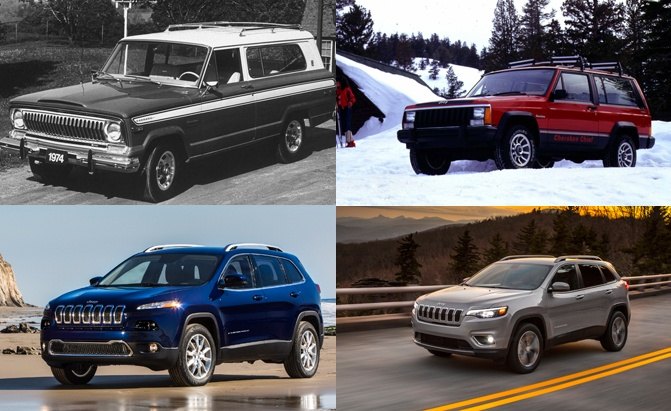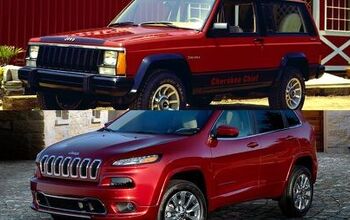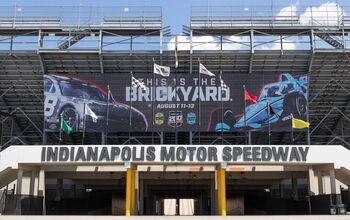10 Interesting Facts From the History of the Jeep Cherokee

Well before its current incarnation, the Jeep Cherokee enjoyed a long and distinguished career as an SUV that defied convention and introduced numerous innovations that the rest of the automotive industry scrambled to match.
It pioneered a number of compact sport-utility features and characteristics that we take for granted today. And despite a decade-plus hiatus, the Cherokee returned and picked up where it left off in terms of standing out from the crowd.
It has since been refreshed, but true to the original vehicle’s mission. To better under this popular model’s history, here are 10 interesting facts on the Jeep Cherokee.
ALSO SEE: Jeep Renegade vs Compass: Which Jeep is Right for You?1. The First Unibody SUV

When the 1984 Jeep Cherokee (or XJ as it was known internally) first hit the market, it didn’t just set itself apart from the larger, more primitive Jeep models that came before it — it also managed to distance itself from every one of its sport-utility vehicle peers. The biggest difference was the Cherokee’s unibody construction, which swapped the heavy and cumbersome body-on-frame platform in favor of the a more car-like structure. This imbued the small Jeep with far more nimble handling coupled with better fuel mileage than its peers thanks to its light (3,000 lbs or so) curb weight while preserving the rugged strength required to tackle off-road terrain.
ALSO SEE: The Only 15 ‘Real’ SUVs Left on the Market2. Truck Like Towing, Car-Like Footprint

While it might have been smaller and less beefy than a truck-based hauler, the Jeep Cherokee managed to maintain the utility that SUV shoppers were looking for. When equipped with a towing package, the Cherokee was capable of pulling in the neighborhood of 5,000 lbs, although most models were sold with a 2,000-pound capacity. Also impressive? 71 cubic feet of total cargo space, a number that stands tall even all these years later when compared against a host of other entry-level people movers that have come and gone. This copious carrying capability came despite the Jeep’s sedan-like length and width.
3. Unheard Of Four-Door Practicality

It might seem unusual to laud the XJ Jeep Cherokee for offering compact SUV fans a four-door option, but in 1984, it was the only trucklet on the block to do so. The Chevrolet S10 Blazer and the Ford Bronco II were squarely in the two-door camp, and it would be several years before any other automaker would catch up to Jeep’s doubling down on passenger ingress and egress. For families, it was an easy choice to make, and for traditionalists, there was still a two-door model available.
4. Real Ground Clearance, Real Four-Wheel Drive

If the Jeep Cherokee had merely been a jacked-up station wagon, it would never have caught on in the imaginations of off-roaders like the XJ did. Take a peek underneath the truck and it’s clear to see that the engineers at Jeep didn’t see its unibody platform as a weakness, because you’ll find a pair of solid axles slung front (Dana 30) and rear (Dana 35, 44, or Chrysler-sourced), connected by way of several available transfer cases, including full-time four-wheel drive on some models and available low-range gearing. Coil springs up front helped with wheel articulation while improving on-road comfort, and the Cherokee topped out at a healthy 8.3 inches of ground clearance – roughly the same amount you’d find on a modern-day Jeep Grand Cherokee.
ALSO SEE: 2018 Jeep Wrangler JL Review and First Drive
5. The Last AMC Engine, Ever

One of the most memorable aspects of the XJ Cherokee’s personality was its 4.0-liter inline six-cylinder engine. This was the final motor ever developed by AMC, the company that developed the compact Jeep before its assets were sold to Chrysler. It would last from its inception in the 1987 model year all the way to the final 2001 edition of the Cherokee. Originally it offered 177 ponies, but a series of revisions would bring that figure up to just over 190 horsepower and a healthy 231 lb-ft of torque. Commonly matched with a four-speed automatic gearbox (although a five-speed manual was also available), later versions of the motor developed a well-earned reputation for being unkillable.
6. A Litany Of Other Motors (To Avoid)

Of course, things weren’t always rosy for the Jeep Cherokee in the engine compartment, especially during the first three years of production where AMC struggled to find a clear path forward for the small SUV. Out of the box, it came with a 2.5-liter four-cylinder that struggled to generate 105 smog-choked horses in 1984, with another 10 horsepower available from a 2.8-liter V6 sourced from General Motors if buyers chose to upgrade. There was even, at one point, a diesel four-banger shipped across the ocean by Renault to frustrate Cherokee owners hoping to actually ever merge with traffic.
7. Nearly 3 Million Built

The Jeep Cherokee is viewed in some circles as an almost ‘disposable’ off-roader, simply because there are so many out there. If something bad happens to yours out on the trail, you can easily pull the parts you need off of it and snag a new one for very little money. Between 1984 and 2001, there were an astounding 2,884,172 examples sold around the world, making it one of the most popular SUVs of all time.
8. Don’t Forget The SJ

If you reach back far enough in Jeep’s history, you’ll find another vehicle called the Cherokee, only this one’s a whole lot bigger. The SJ generation of the Cherokee nameplate was a two-door version of the popular Wagoneer, a full-size off-roader that had been available since Jeep’s Kaiser days. From 1974 to 1977, it was exclusively a two-door vehicle offering a lower standard of equipment than the Wagoneer. But by 1977 it had gained a four-door body style as well, which it would maintain until it went off the market in 1983.
9. Reviving a Legend

The Cherokee name lived on outside of North America after the XJ was retired on products sold as the Liberty state-side. It wasn’t until the 2014 model year that the Jeep Cherokee officially returned to its home turf. Importing a platform developed by new European corporate overlord Fiat, the Cherokee featured a choice between three different four-wheel-drive systems, came with a novel nine-speed automatic gearbox and offered four and six-cylinder engines. The shark-nosed styling polarized Jeep fans, but there was an off-road-ready Trailhawk edition for those looking to get their rims dirty. The new Cherokee carried on the spirit, if not the design details, of its predecessor.
10. Stacking Up Against the Modern Cherokee

Curious about how the current Jeep Cherokee compares to the lauded XJ? For starters, the new model is a full 5.1 inches longer, but delivers roughly 15 cubic feet less cargo space in total. In terms of power, however, it’s no contest – even the base 2.4-liter four-cylinder in the new Cherokee is within a few horsepower of the mightiest 4.0, with the optional 3.2-liter V6 throwing down 271 horses, or roughly 50 percent more than what its ancestor brought to the table.
Tech-wise, it’s clear that the modern safety and infotainment systems found in the new Jeep Cherokee are also a step up over the XJ, which at one point was available without airbags or even anti-lock brakes. In terms of off-road capability, however, it may be a draw: the Trailhawk uses a variety of electronics to complement its low-range gearing and locking axles (including a 56:1 slow-speed creeper ratio), posts 8.7 inches of ground clearance, and comes with the Selec-Terrain system that allows drivers to dial-in their driving environment (including snow, sand/mud, and rock crawling).
Become an AutoGuide insider. Get the latest from the automotive world first by subscribing to our newsletter here.
Recent Updates:
November 25, 2021 – Updated introduction for accuracy. Updated titles. The First Unibody SUV text updated for accuracy. Updated Real Ground Clearance, Real Four-Wheel Drive text for accuracy. The Last AMC Engine, Ever text updated for accuracy. A Litany Of Other Motors (To Avoid) text updated for accuracy. Nearly 3 Million Built text updated for readability. Don’t Forget The SJ text updated for readability. Reviving a Legend text updated for accuracy. Stacking Up Against the Modern Cherokee text updated for accuracy.
More by Benjamin Hunting































Comments
Join the conversation